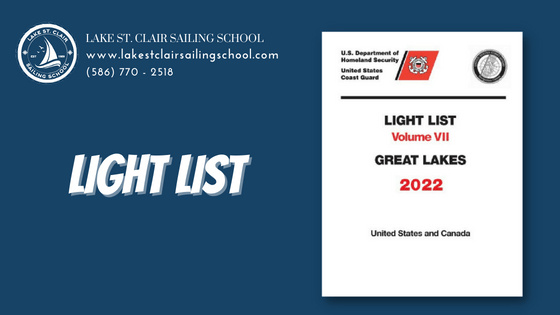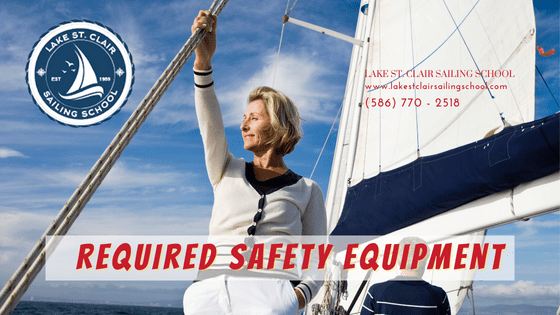Lake St. Clair Sailing School sailing events
What is IALA IALA is The International Association of Marine Aids to Navigation and Lighthouse Authorities. (IALA) is a nonprofit international technical association. It was established in 1957 and it provides nautical expertise and advice. IALA encourage its members to work together to harmonized aids to navigation worldwide and to insure the movements of the vessels are safe and cost effective. IALA is known for its buoyage system In order to minimize the number of changes to the current existing systems, are you all decided to create a system divided into two regions. Which depends upon geographical location. There is region eight and there is region be. North, central and south America is…

IALA
LIGHT LIST (2021 ANNUAL PUBLICATION) https://www.navcen.uscg.gov/?pageName=lightLists
Anchor Types Kedge Anchors – Used for centuries they are the traditional anchor shape we are used to. Modern kedge style anchors are lighter and have been adapted for specialized use. Sharp bills and small flukes hold better in hard sand. Broader flukes and larger arms hold better in soft bottoms or rocks and coral. Kedge anchors are often used successfully in heavy vegetation. *Softer bottoms, hard sand, Rocks and Coral, Weeds Plow Anchors – When the plow anchor first lands, it is on its side but as it gets pulled the anchor rights itself and gradually plows into the bottom. It buries itself and holds well. Because this anchor type swivels horizontally on a hinged shaft,…
Life JacketsA properly fitting and serviceable jacket for every person on board. Fire ExtinguisherIt must be a Coast Guard-approved B1 model. ThrowableBoats over 16 feet must carry a throwable device. Signaling DeviceA bell, whistle, or horn to warn other boaters. Visual Distress SignalPhoto of a hand flare For boats under 16 feet, this is required only at night; for boats over 16 feet, this is required both day and night. Different rules apply on small bodies of water, but it’s always wise to carry them.

Required Safety Equipment
Towing A power-driven vessel when towing shall exhibit: two masthead lights in a vertical line. When the length of the tow, measuring from the stern of the towing vessel to the after end of the tow exceeds 200 metres, three such lights in a vertical line;sidelights;a sternlight;a towing light in a vertical line above the sternlight;when the length of the tow exceeds 200 metres, a diamond shape where it can best be seen. Tugboat longer than 50 m - tow longer than 200 mAbeam, port sideAhead, Day sign(diamond shapes)AheadAsternTugboat shorter than 50 m - tow longer than 200 mAbeam, port sideAhead, Day sign(diamond shapes)AheadAsternTugboat longer than 50 m - tow shorter than 200…
Aground Aground, longer than 50 mDay sign (3 black spheres)Abeam, port sideAheadAstern
Anchoring Lights (Colreg) Colreg rules. Lights during anchoring. Vessel of less than 50 m in length at anchor from sunset to sunrise and from sunrise to sunset in restricted visibility Anchored vessel, longer than 50 mDay sign (1 black sphere)Abeam, port sideAheadAsternAnchored vessel, shorter than 50 mDay sign (1 black sphere)Abeam, port sideAheadAsternAnchored sailing boatDay sign (1 black sphere)Abeam, port sideAheadAstern
Sailing and Motoring A vessel proceeding under sail which has her engine running shall exhibit forward where it can best be seen a conical shape, apex downwards.She shall exibit lights according to a power-driven vessel. Sailing and motoringDay signAbeam, port sideAheadAstern
Sailing vessels underway and vessels under oars A sailing vessel underway shall exhibit: sidelights;a sternlight. In a sailing vessel of less than 20 metres in length the lights may be combined in one lantern carried at or near the top of the mast where it can best be seen. A sailing vessel underway may, in addition to the lights, exhibit at or near the top of the mast, where they can best be seen, two all-round lights in a vertical line, the upper being red and the lower green, but these lights shall not be exhibited in conjunction with the combined lantern. A sailing vessel of less than 7 metres in length shall,…
Power-driven vessel underway A power-driven vessel underway shall exhibit: a masthead light forward;a second masthead light abaft of and higher than the forward one; except that a vessel of less than 50 metres in length shall not be obliged to exhibit such light but may do so;sidelights;a sternlight. Power driven vessel underway, longer than 50 mAbeam, port sideAheadAsternPower driven vessel underway, shorter than 50 mAbeam, port sideAheadAstern






